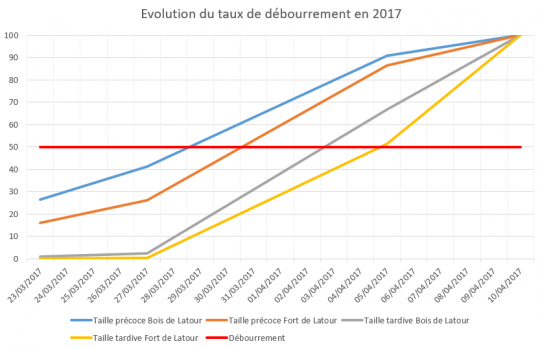Late pruning trials were carried out at Château Latour with several objectives, the main one being to shift the vine's phenological cycle and thereby shorten the frost risk period. Another objective was for the grapes to ripen slightly later.
These trials were repeated and monitored for three years on the same plots.
2.1.1.f Results of late pruning trials at Château Latour
Methodology
Pruning trials were carried out on two of the Merlot plots in the Enclos in 2017. The Bois de Latour and Fort de Latour plots were divided into two sections: one section was pruned at the very beginning of the season, in November, while the other section was pruned 110 days later, in March 2017.
We monitored two rows for each of these plots throughout the growth cycle - one row in the early pruning section and the other in the late pruning section - with the goal of measuring any differences.
Measurements
Phenological stages
Water stress
Branch growth speed
Ripeness
Results
Phenological stages
There was a clear difference in budburst between the plots pruned early and those pruned later in the season. Budburst in the early-pruned rows of Bois de Latour and Fort de Latour occurred on 29 and 31 March respectively, while for the late-pruned rows, budburst was on 3 April for Bois de Latour and 5 April for Fort de Latour. In 2018, there was a difference in budburst of 15 days (1 April 1 compared to 15 April).
Subsequently, the late-pruned plots caught up with less difference between the flowering dates: the Bois de Latour early-pruned section flowered on 25 May while the late-pruned rows in Bois de Latour and both sections of Fort de Latour flowered on 26 May. In 2018, there was a 4-day difference between the late and early rows at the flowering stage.
During the véraison (colour-change), both early-pruned plots were marginally in advance of the mid-colour-change date.
The early-pruned plots changed colour on 29 July 2017. The late-pruned plots for Fort de Latour showed a slight difference compared to the mid-colour-change date of 30 July, while Bois de Latour changed colour on 31 July, two days after the early-pruned section.
Early and late pruning did not have a notable impact on the other variables in the study (pre-dawn leaf water potential, primary growth and nitrogen nutrition).
Ripeness
On 8 August 2017, the date of the first ripeness assessment, there were still significant differences between plots with different pruning methods.
For example, the total acidity of the early-pruned Fort de Latour plot was 8.1 g/L, compared to 9 for the late-pruned plot.
The difference diminished as the grapes ripened, and they were both measured at 3.35 on 29 August 2017.
Analyses carried out at the start of harvesting showed no significant difference between the two pruning methods. The vines were therefore able to compensate in terms of growth, and also in terms of ripening as the season progressed.
Conclusion
The main benefit of late-pruning for us is the delayed budburst, since the vines caught up and, by harvest time, there was hardly any difference.
Over the course of the trial years, we observed an average of 7 to 10 days delay in budburst due to late pruning compared to early pruning.
In our situation, late-pruning is practised in the zones most at risk of frost to shorten the risk window, without completely eliminating it.

